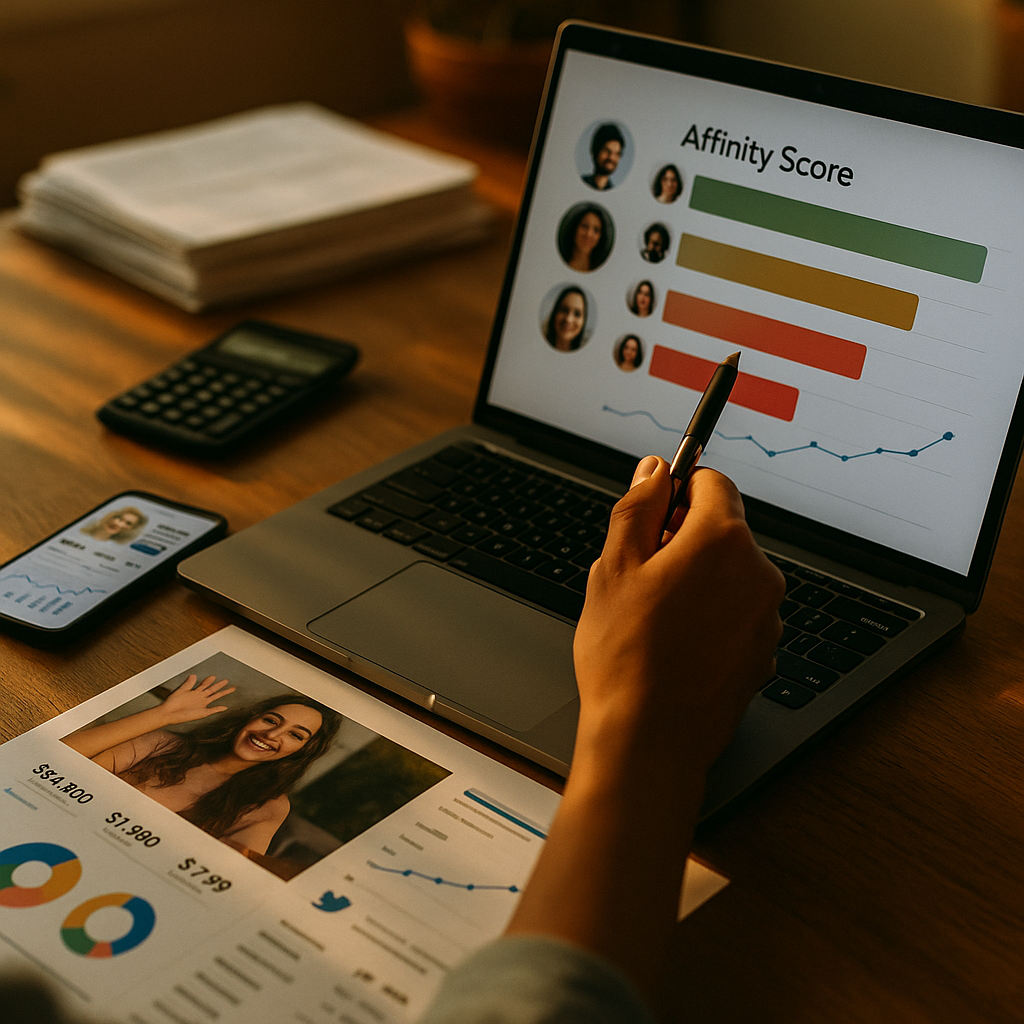Using affinity scores to find creators whose audiences perfectly match your ICP is now essential for brands seeking meaningful ROI from their influencer marketing. In 2025’s crowded creator space, precision is power—brands must ensure every partnership reaches the right eyes. Discover the real steps to identify creators whose followers mirror your ideal customer profile.
Understanding Affinity Scores in Influencer Marketing
Affinity scores measure the alignment between a creator’s audience and your ideal customer profile (ICP). This crucial metric combines follower demographics, interests, behavior patterns, and engagement data to predict how likely an audience is to respond favorably to your products or services. By relying on affinity scores, marketers step beyond vanity metrics—like follower count—and focus on audience quality and relevance.
Experts note that while reach remains important, it’s the fit between audience and ICP that drives genuine conversions. Affinity scoring systems, available on advanced influencer platforms in 2025, leverage AI to analyze tens of thousands of data points. This transformation allows brands—whether B2B or B2C—to select creators whose communities mirror their target buyers, narrowing waste and amplifying campaign effectiveness.
How to Define Your Ideal Customer Profile (ICP) with Precision
Success with affinity scores depends on a crystal-clear definition of your ICP. In 2025, top-performing brands revisit ICPs regularly, updating them as markets shift and consumer preferences evolve. Your ICP should detail:
- Demographics: Age, gender, location, income, education, profession
- Psychographics: Interests, lifestyle, values, motivations
- Buying Behaviors: Purchase channels, average order value, frequency
- Pain Points: Problems your solution addresses
Once the ICP is defined, marketers feed the data into influencer discovery tools that track affinity scores. The clearer your ICP, the more accurate the alignment algorithms become. Remember, in-depth ICP development empowers technology to deliver high-impact creator matches.
Leveraging Advanced Affinity Score Tools for Accurate Creator Selection
Today’s best influencer marketing platforms offer robust affinity scoring. These tools use advanced machine learning to map how closely a creator’s audience resembles your ICP. Key features include:
- Demographic and Psychographic Matching: Match creators based on multiple ICP attributes, including niche interests and intent signals.
- Granular Filters: Filter creators by audience overlap percentage, engagement rates within target segments, and follower authenticity.
- Predictive Analytics: Estimate potential campaign outcomes based on historical brand-creator affinities.
For example, if your ICP targets urban, sustainability-conscious millennials, advanced platforms in 2025 surface only those creators whose communities show measured alignment—down to sentiment on green products and urban lifestyle hashtags. Brands using such technology report up to 35% higher conversion from influencer campaigns compared to generic partnerships, according to recent industry data.
Implementing Affinity Scores in Creator Outreach and Campaign Design
Affinity scoring extends its value beyond the search process—it enables smarter outreach and campaign planning. When reaching out to creators, referencing their audience’s specific alignment with your ICP demonstrates preparation and seriousness, setting partnerships on the right foundation.
During campaign design, rely on affinity data to tailor messaging. Creators with highly aligned audiences benefit from campaign briefs that echo their community’s unique needs and aspirations. This alignment has been shown to lift post engagement rates by as much as 42% over campaigns that overlook audience affinities.
- Use affinity scores to create tiered creator lists for phased campaigns.
- Personalize incentives and compensation for top affinity matches—these creators often bring the best ROI.
- Continuously monitor post-campaign affinity metrics to fine-tune future outreach and reiterate ICP definitions.
Measuring the Real Impact: From Affinity Scores to Business Results
Tracking effectiveness is vital for proving value to stakeholders. In 2025, leading marketing teams integrate affinity score analytics with first-party sales, CRM, and web analytics for closed-loop attribution. Essential metrics include:
- Click-through and Conversion Rates: Segmented by audience affinity to link outcomes with ICP alignment
- LTV of Customers Acquired: Evaluates whether aligned audiences bring higher-value buyers
- Brand Lift Surveys: Measures shifts in awareness and sentiment among segments mapped by affinity score
Brands using affinity-driven creator collaborations report more consistent results and lower customer acquisition costs. By focusing on audiences whose needs and values match your ICP, every marketing dollar goes further—turning influencer budgets into a repeatable growth engine.
FAQs on Using Affinity Scores to Match Creators With Your ICP
-
What is an affinity score in influencer marketing?
An affinity score measures how closely a creator’s audience matches your defined ideal customer profile (ICP), using data signals like demographics, psychographics, interests, and engagement patterns.
-
How do I calculate or access affinity scores?
In 2025, leading influencer discovery platforms offer built-in affinity scoring tools. Simply input your ICP criteria, and the platform calculates alignment scores for thousands of creators automatically.
-
Can affinity scores prevent wasted ad spend?
Yes, by partnering only with creators whose audiences closely align with your ICP, you significantly reduce irrelevant impressions, increasing the efficiency and ROI of your influencer campaigns.
-
What factors influence a high affinity score?
Strong matches occur when follower demographics, interests, behaviors, and sentiments reflect your ICP. The more detailed your ICP, the more accurate your affinity scores will be.
-
How often should I update my ICP and affinity parameters?
Review and update your ICP at least quarterly—or after any major shifts in product, market, or audience—from both qualitative insights and campaign performance data.
In 2025, using affinity scores to find creators whose audiences perfectly match your ICP is the surest way to turn influencer marketing into a predictable growth lever. Prioritize data-driven partnerships, keep your ICP definitions sharp, and let affinity metrics guide your collaborations for impactful, sustainable results.
